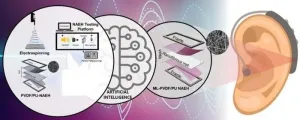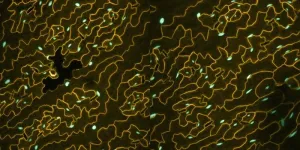(Press-News.org) (LOS ANGELES) June 3, 2024 – Scientists at the Terasaki Institute for Biomedical Innovation (TIBI), have employed artificial intelligence techniques to improve the design and production of nanofibers used in wearable nanofiber acoustic energy harvesters (NAEH). These acoustic devices capture sound energy from the environment and convert it into electrical energy, which can then be applied in useful devices, such as hearing aids.
Many efforts have been made to capture naturally occurring and abundant energy sources from our surrounding environment. Relatively recent advances such as solar panels and wind turbines allow us to efficiently harvest energy from the sun and wind, convert it into electrical energy, and store it for various applications. Similarly, conversions of acoustic energy can be seen in amplifying devices such as microphones, as well as in wearable, flexible electronic devices for personalized healthcare.
Currently, there has been much interest in using piezoelectric nanogenerators - devices that convert mechanical vibrations, stress, or strain into electrical power – as acoustic energy harvesters. These nanogenerators can convert mechanical energy from sound waves to generate electricity; however, this conversion of sound waves is inefficient, as it occurs mainly in the high frequency sound range, and most environmental sound waves are in the low frequency range. Additionally, choosing optimal materials, structural design, and fabrication parameters make the production of piezoelectric nanogenerators challenging.
As described in their paper in Nano Research, the TIBI scientists’ approach to these challenges was two-fold: first, they chose their materials strategically and elected to fabricate nanofibers using polyvinylfluoride (PVDF), which are known for their ability to capture acoustic energy efficiently. When making the nanofiber mixture, polyurethane (PU) was added to the PVDF solution to impart flexibility, and electrospinning (a technique for generating ultrathin fibers) was used to produce the composite PVDF/PU nanofibers.
Secondly, the team applied artificial intelligence (AI) techniques to determine the best fabrication parameters involved in electrospinning the PVDF/polyurethane nanofibers; these parameters included the applied voltage, electrospinning time, and drum rotation speed. Employing these techniques allowed the team to tune the parameter values to obtain maximum power generation from their PVDF/PU nanofibers.
To make their nanoacoustic energy harvester, the TIBI scientists fashioned their PVDF/PU nanofibers into a nanofibrous mat and sandwiched it between aluminum mesh layers that functioned as electrodes. The entire assembly was then encased by two flexible frames.
In tests against conventionally fabricated NAEHs, the resultant AI-generated PVDF/PU NAEHs were found to have better overall performance, yielding a power density level more than 2.5 times higher and a significantly higher energy conversion efficiency (66% vs 42%). Furthermore, the AI-generated PVDF/PU NAEHs were able to obtain these results when tested with a wide range of low-frequency sound – well within the levels found in ambient background noise. This allows for excellent sound recognition and the ability to distinguish words with high resolution.
“Models using artificial intelligence optimization, such as the one described here, minimize time spent on trial and error and maximize the effectiveness of the finished product,” said Ali Khademhosseini, Ph.D., TIBI’s director and CEO. “This can have far-reaching effects on the fabrication of medical devices with significant practicability.”
Authors: Negar Hosseinzadeh Kouchehbaghi, Maryam Yousefzadeh, Aliakbar Gharehaghaji, Safoora Khosravi, Danial Khorsandi, Reihaneh Haghniaz, Ke Cao, Mehmet R. Dokmeci, Mohammad Rostami, Ali Khademhosseini & Yangzhi Zhu
###
About the Terasaki Institute for Biomedical Innovation
The Terasaki Institute for Biomedical Innovation is accelerating the pace of translational research by supporting the world’s leading scientists with an open, entrepreneurial environment for bioengineering new materials, biological models, and advanced technologies to address critical challenges to the health of the planet and its people. The Institute’s worldwide collaborations with academic, clinical, and entrepreneurial partners provide a rich foundation for translating innovations to the real world.
Contact:
Stewart Han
President
Terasaki Institute for Biomedical Innovation
shan@terasaki.org
END
Enhancing nanofibrous acoustic energy harvesters with artificial intelligence
Maximizes production and performance of wearable sound amplifiers
2024-06-03
ELSE PRESS RELEASES FROM THIS DATE:
Research pioneer and paradigm-shifting thought leader for breast cancer precision medicine to receive the 2024 Szent-Györgyi Prize for Progress in Cancer Research
2024-06-03
June 3, 2024 (Rockville, MD)
The National Foundation for Cancer Research (NFCR) is announcing that the blue-ribbon selection committee, composed of world-renowned research leaders and visionaries, has awarded the 2024 Szent-Györgyi Prize for Progress in Cancer Research to Dennis J. Slamon, M.D., Ph. D. from UCLA Health for his groundbreaking research discoveries that helped to shape the field of precision medicine for breast cancer patients.
The cancer research community will celebrate Dr. ...
Assessing the environmental and downstream human health impacts of decentralizing cancer care
2024-06-03
About The Study: This cohort study found that using decentralization through telemedicine and local care may substantially reduce cancer care’s greenhouse gas emissions; this corresponds to small reductions in human mortality.
Corresponding Author: To contact the corresponding author, Gregory A. Abel, M.D., M.P.H., email gregory_abel@dfci.harvard.edu.
To access the embargoed study: Visit our For The Media website at this link https://media.jamanetwork.com/
(doi:10.1001/jamaoncol.2024.2744)
Editor’s Note: Please see the article for additional information, including other authors, author contributions and affiliations, ...
Telehealth can significantly reduce greenhouse gas emissions associated with cancer care, study finds
2024-06-03
BOSTON – Telemedicine visits for cancer care may not only be more convenient and easier to schedule than in-person appointments, they're also better for the planet, new research by Dana-Farber Cancer Institute scientists shows.
Based on an analysis of data from a regional cancer center, the researchers calculate that, nationwide, cancer care that utilizes telehealth and local care would generate 33.1% less greenhouse gas emissions than the traditional model of in-person care, primarily because of reduced travel to medical appointments. ...
Brain waves shape the words we hear
2024-06-03
The timing of our brain waves shapes how we perceive our environment. We are more likely to perceive events when their timing coincides with the timing of relevant brain waves. Lead scientist Sanne ten Oever and her co-authors set out to determine whether neural timing also shapes speech perception. Is the probability of speech sounds or words encoded in our brain waves and is this information used to recognise words?
The team first created ambiguous stimuli for both sounds and words. For instance, the initial sounds in da and ga differ in probability: ‘d’ is more common than ‘g’. The Dutch words dat “that” and gat “hole” ...
Geographic distribution of clinical trials for advanced-stage cancer
2024-06-03
About The Study: This quality improvement analysis of clinical trials for metastatic breast, lung, colon, pancreatic, and prostate cancers found that a large proportion of the U.S. population lived within 30 miles of a clinical trial site. This finding suggests that while many clinical trials are available, they are not evenly distributed across the country and may not be accessible to all individuals, particularly racial and ethnic minority individuals. This disparity in access to clinical trials raises important questions about equity and fairness in the distribution of health care resources and opportunities ...
PSU secures $1 million grant for high-performance computing cluster across Oregon
2024-06-03
Portland State will power up a new high-performance computing cluster that will give researchers at universities and colleges across Oregon the ability to advance computing-intensive research projects by processing large datasets and performing complex computations in a fraction of the time — thanks to a nearly $1 million grant from the National Science Foundation’s Campus Cyberinfrastructure program.
The Oregon Regional Computing Accelerator (Orca) aims to provide free-of-cost computing resources and cyberinfrastructure ...
New $12.5 million National Science Foundation grant awarded to study phenomenon affecting agriculture, cancer, biodiversity and more
2024-06-03
It’s in your heart and liver, in the vegetables you eat, in the rogue cells that cause cancer. Those who live in temperate regions are surrounded by more of it than people who live in the tropics, and without it, humans wouldn’t exist.
It’s called polyploidy, and only within the last few years have biologists begun to recognize its significance across the tree of life.
“It’s one of the most important biological processes that hardly anybody knows about,” said Doug Soltis, a distinguished professor at the Florida Museum of Natural History.
Soltis is one of 18 scientists who have received a combined ...
SwRI-led team to bolster earthquake readiness for U.S. Federal Highway Administration
2024-06-03
SAN ANTONIO — June 3, 2024 — Southwest Research Institute will enhance models to strengthen the earthquake resilience of America’s transportation infrastructure and improve public safety in earthquake-prone areas. As part of a contract with the U.S. Federal Highway Administration (FHWA), an SwRI-led team will update and improve liquefaction models. Liquefaction occurs during an earthquake when intense shaking causes soil to temporarily act more like a fluid, losing its capacity to support roads and structures.
“For highways specifically, sometimes state and ...
Updating the way the Lab computes
2024-06-03
Unraveling the behavior of plasma increasingly requires intensive computing resources. That’s why plasma demands a calculated approach to computation.
As the new head of computational sciences at the U.S. Department of Energy’s (DOE) Princeton Plasma Physics Laboratory (PPPL), Shantenu Jha is excited to be at the helm of the Lab’s computing efforts, fusing computer science expertise with PPPL’s pioneering research into the fourth state of matter.
“I want to continue to grow the excellence that already exists in computing for fusion energy at PPPL, which ...
New study finds popular diabetes and weight-loss drugs associated with reduction in incidence and recurrence of alcohol-use disorder by at least half
2024-06-03
CLEVELAND—A new study by researchers at the Case Western Reserve University School of Medicine reveals that the popular diabetes and weight-loss drugs Wegovy and Ozempic are linked to reduced incidence and recurrence of alcohol abuse or dependence.
The team’s findings, recently published in the journal Nature Communications, may suggest a possible new treatment for excessive alcohol use—including alcohol-use disorder (AUD), a health condition that causes about 178,000 deaths in the United States each year, according to the Centers for Disease Control.
To date, the U.S. Food and Drug Administration (FDA) has approved only three medications to treat AUD.
The active ingredient ...
LAST 30 PRESS RELEASES:
Drone sampling of whale breath reveals first evidence of potentially deadly virus in Arctic
Roman soldiers defending Hadrian’s Wall infected by parasites, study finds
Pinochet’s prisoners were tormented with music but still found solace in it, a new book reveals
Fertility remains high in rural Tanzania despite access to family planning
AI-assisted device can improve autism care access
Kinetic careers
Uncovering how parasitic plants avoid attacking themselves to improve crop resistance
Nanoparticle vaccine strategy could protect against Ebola and other deadly filoviruses
Study finds brain care score can predict risk of stroke across racial groups
Key lung immune cells can intensify allergic reactions
Do hormones explain why women experience more gut pain?
New materials conduct ions in solids as easily as in liquids
Breakthrough of the Year: Renewable energy begins to eclipse fossil fuel-based sources
LLM use is reshaping scientific enterprise by increasing output, reducing quality and more
Introducing LightGen, a chip for ultra-fast, ultra-efficient generative AI
Astronomers see fireworks from violent collisions around nearby star
ACC/AHA issue new guideline on managing congenital heart disease in adults
Cosmic crash caught on camera
Is talented youth nurtured the wrong way? New study shows: top performers develop differently than assumed
Ants: An untapped resource in the development of antibiotics?
Archaeologists use AI to create prehistoric video game
Mitochondria migrate toward the cell membrane in response to high glucose levels
Tiny viral switch offers hope against drug-resistant bacteria
Most parents aware of early peanut introduction guidelines, but confused about details
HPV vaccine can protect against severe lesions of the vulva and vagina
Virtual care provision and emergency department use among children and youth
Quadrivalent HPV vaccine and high-grade vulvovaginal lesions
Insights into dry eyes gained from stem cell-derived tear glands
Researchers identify 166 human pluripotent stem cell lines available for use in clinical applications
Europa Clipper instrument uniquely observed interstellar comet 3I/ATLAS
[Press-News.org] Enhancing nanofibrous acoustic energy harvesters with artificial intelligenceMaximizes production and performance of wearable sound amplifiers






